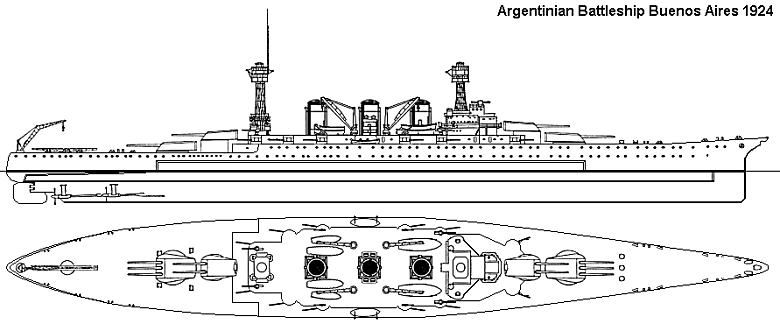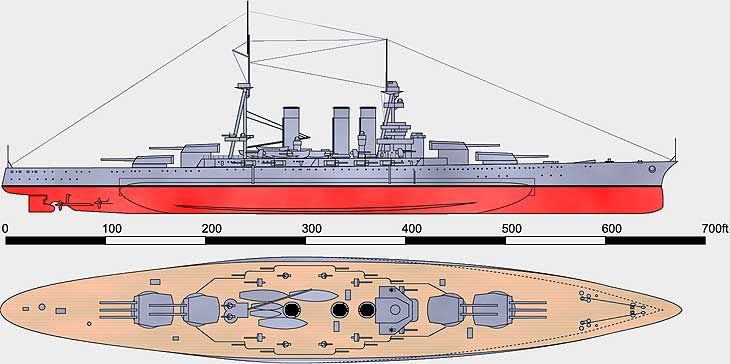
Apparently I built Argentina a 30 knot battleship with 10x14" guns sometime in the early 1920's. Here's what I think it might look like. Built by Fore River and based on a shrunken down version of a Fast South Dakota. Apparently they wanted something rather large!

Buenos Aires, Argentinian Battleship laid down 1921
Displacement:
39,660 t light; 41,374 t standard; 42,958 t normal; 44,225 t full load
Dimensions: Length overall / water x beam x draught
751.05 ft / 740.00 ft x 102.00 ft (Bulges 106.00 ft) x 32.00 ft (normal load)
228.92 m / 225.55 m x 31.09 m (Bulges 32.31 m) x 9.75 m
Armament:
6 - 14.00" / 356 mm guns (2x3 guns), 1,372.00lbs / 622.33kg shells, 1921 Model
Breech loading guns in turrets (on barbettes)
on centreline ends, evenly spread
4 - 14.00" / 356 mm guns (2x2 guns), 1,372.00lbs / 622.33kg shells, 1921 Model
Breech loading guns in turrets (on barbettes)
on centreline ends, evenly spread, all raised mounts
16 - 5.00" / 127 mm guns in single mounts, 62.50lbs / 28.35kg shells, 1921 Model
Breech loading guns in casemate mounts
on side, evenly spread, 4 raised mounts
4 - 3.00" / 76.2 mm guns in single mounts, 13.50lbs / 6.12kg shells, 1921 Model
Breech loading guns in deck mounts
on side, all amidships, all raised mounts - superfiring
Weight of broadside 14,774 lbs / 6,701 kg
Shells per gun, main battery: 100
4 - 21.0" / 533.4 mm submerged torpedo tubes
Armour:
- Belts: Width (max) Length (avg) Height (avg)
Main: 13.5" / 343 mm 459.00 ft / 139.90 m 12.12 ft / 3.69 m
Ends: 6.00" / 152 mm 281.00 ft / 85.65 m 12.12 ft / 3.69 m
Upper: 5.00" / 127 mm 459.00 ft / 139.90 m 8.00 ft / 2.44 m
Main Belt covers 95 % of normal length
- Torpedo Bulkhead and Bulges:
2.00" / 51 mm 459.00 ft / 139.90 m 30.73 ft / 9.37 m
- Gun armour: Face (max) Other gunhouse (avg) Barbette/hoist (max)
Main: 16.0" / 406 mm 7.00" / 178 mm 13.0" / 330 mm
2nd: 16.0" / 406 mm 7.00" / 178 mm 13.0" / 330 mm
3rd: 3.00" / 76 mm - -
- Armour deck: 5.00" / 127 mm, Conning tower: 16.00" / 406 mm
Machinery:
Oil fired boilers, steam turbines,
Geared drive, 4 shafts, 161,011 shp / 120,114 Kw = 30.00 kts
Range 7,000nm at 12.00 kts
Bunker at max displacement = 2,851 tons
Complement:
1,491 - 1,939
Cost:
£9.458 million / $37.832 million
Distribution of weights at normal displacement:
Armament: 1,847 tons, 4.3 %
Armour: 15,224 tons, 35.4 %
- Belts: 4,829 tons, 11.2 %
- Torpedo bulkhead: 1,044 tons, 2.4 %
- Armament: 3,826 tons, 8.9 %
- Armour Deck: 5,102 tons, 11.9 %
- Conning Tower: 423 tons, 1.0 %
Machinery: 5,544 tons, 12.9 %
Hull, fittings & equipment: 16,945 tons, 39.4 %
Fuel, ammunition & stores: 3,298 tons, 7.7 %
Miscellaneous weights: 100 tons, 0.2 %
Overall survivability and seakeeping ability:
Survivability (Non-critical penetrating hits needed to sink ship):
56,738 lbs / 25,736 Kg = 41.4 x 14.0 " / 356 mm shells or 8.1 torpedoes
Stability (Unstable if below 1.00): 1.03
Metacentric height 5.5 ft / 1.7 m
Roll period: 19.0 seconds
Steadiness - As gun platform (Average = 50 %): 60 %
- Recoil effect (Restricted arc if above 1.00): 0.69
Seaboat quality (Average = 1.00): 1.07
Hull form characteristics:
Hull has low quarterdeck
Block coefficient: 0.599
Length to Beam Ratio: 6.98 : 1
'Natural speed' for length: 27.20 kts
Power going to wave formation at top speed: 55 %
Trim (Max stability = 0, Max steadiness = 100): 56
Bow angle (Positive = bow angles forward): 18.00 degrees
Stern overhang: 0.00 ft / 0.00 m
Freeboard (% = measuring location as a percentage of overall length):
- Stem: 34.00 ft / 10.36 m
- Forecastle (22 %): 27.00 ft / 8.23 m
- Mid (66 %): 27.00 ft / 8.23 m
- Quarterdeck (20 %): 18.40 ft / 5.61 m (27.00 ft / 8.23 m before break)
- Stern: 18.40 ft / 5.61 m
- Average freeboard: 25.89 ft / 7.89 m
Ship space, strength and comments:
Space - Hull below water (magazines/engines, low = better): 95.3 %
- Above water (accommodation/working, high = better): 190.2 %
Waterplane Area: 55,153 Square feet or 5,124 Square metres
Displacement factor (Displacement / loading): 104 %
Structure weight / hull surface area: 210 lbs/sq ft or 1,026 Kg/sq metre
Hull strength (Relative):
- Cross-sectional: 0.96
- Longitudinal: 1.51
- Overall: 1.00
Hull space for machinery, storage, compartmentation is adequate
Room for accommodation and workspaces is excellent


Quoted
6 - 14.00" / 356 mm guns (2x3 guns), 1,372.00lbs / 622.33kg shells, 1921 Model
Quoted
following the South-Georgian War the survivingQuoted
they would have fewer but heavier guns: ten 14inch guns, in two triple-turrets and two twin-turrets disposed symmetrically fore and aft, twins superfiring.Quoted
unfortunately the order was not placed until after the US entry into the Great War, and so the order was not executed until after the war.Quoted
and plans for classes of cruisers and destroyers
Quoted
Anyway, I hope this little piece is helping to bring some light into the dark...